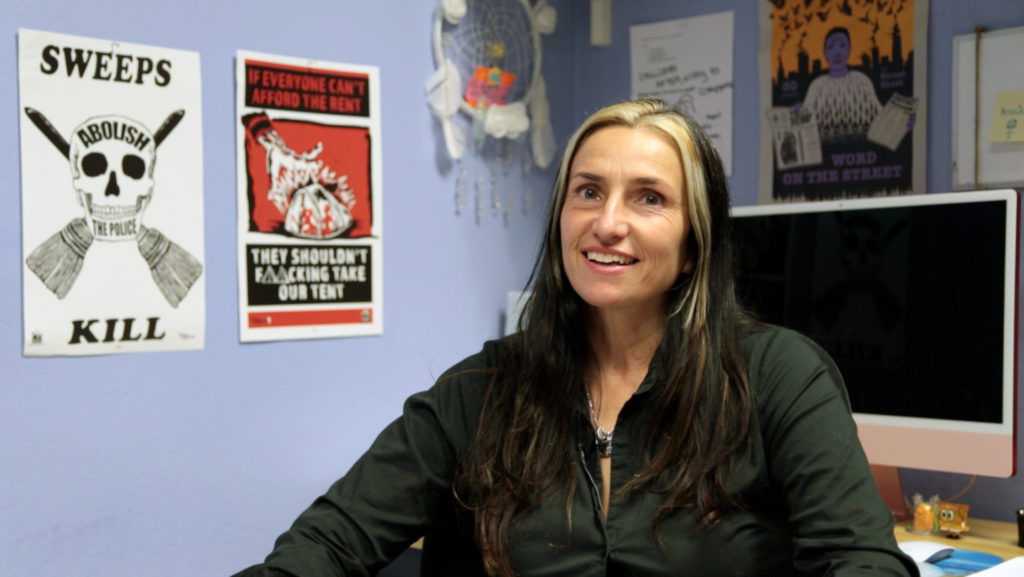https://www.stolenbelonging.org
With encampment sweeps in San Francisco becoming as common a sight as street dwellings themselves, some things are easily observed: large Public Works trucks pulling up, police officers enforcing the operations and unhoused residents scrambling to hold onto what’s left of their possessions that isn’t already thrown in the trucks.
What’s less visible are the traumatic effects unsheltered San Franciscans suffer long after the streets are cleared of sidewalk habitation. Encampment sweeps traumatize those they displace, exacerbating existing mental health conditions.
Diana Valentine, a licensed clinical social worker who has worked with unhoused people in a variety of San Francisco nonprofits for 20 years, discussed at length the harmful impacts of the City’s ongoing efforts to sweep people from corner to corner in an interview with the Stolen Belonging project.
“I would say, absolutely, the sweeps are traumatic,” she said. “The sweeps are using force to remove people, they are using force that creates psychological and physical harm.”
That psychological harm takes the form of post-traumatic stress disorder (PTSD), Valentine said, and she is not alone in her assertion. Describing the impacts of sweeps in a recent lawsuit against the City, an unhoused woman identified as Mia said, “DPW, they’re feared in a way. When they move you, it’s kind of cruel. People will have their pile of personal belongings and then their pile of trash and I’ve seen them [DPW] go behind people’s back and take stuff in their personal belongings pile and throw it away. … I would imagine a lot of people on the street would have PTSD.”
Researchers from the Urban Institute and the University of Hawai’i, among other institutions, also support what Valentine has seen on the ground.
Public records obtained by the Lawyers’ Committee for Civil Rights show that the City didn’t have enough shelter beds available on most days when workers forced residents out of camps from January 1, 2021 to June 30, 2021. Usually, the Healthy Streets Operating Center (HSOC), the multi-agency unit tasked with clearing encampments, estimates having available beds for only 40% of the people they displace at any given site.
Valentine added that trauma from sweeps could make people wary of such offers—especially placements in shelters and navigation centers—even when they’re available.
“There is a dearth of services in the city, and anybody who utilizes services or provides services is aware of that,” she said. “In addition, the services that are offered are oftentimes harmful or retraumatizing and unsafe.”
Trust between residents and outreach workers who tag along with HSOC crews is undermined by these inadequate offers, according to Valentine. The Coalition on Homelessness, the homeless advocacy organization that publishes Street Sheet, has observed HSOC’s operating procedure: Outreach staff arrive around 7 a.m. to collect information from residents for shelter placements while cleaning crews or police order residents to pack up their stuff, then start breaking down tents. By 9:30 a.m., when outreachers learn how many beds are actually available, the sweep is already finished. Few placements, if any, are available to residents who stick around. When that pattern occurs repeatedly, it’s “once bitten, twice shy,” according to Valentine.
“When you add in the impact of the sweeps and you add in the impact of multiple sweeps,” she continued, “What you’re doing is further retraumatizing a person, further demonstrating to them that the support cannot be trusted, that support is essentially a threat.”
The City has launched three special units for behavioral health outreach since 2020—a veritable alphabet soup made up of the Street Crisis Response Team (SCRT), Street Overdose Response Team (SORT) and Street Wellness Response Team (SWRT). The Fire Department and the Department of Public Health staff SCRT and SORT to respond to 911 dispatches involving mental health crises and overdoses. SF Homeless Outreach Team and Fire Department comprise SWRT to answer wellbeing calls. A fourth, the peer-led Compassionate Alternative Response Team (CART), has been budgeted but not yet activated.
To Valentine, the creation of these teams confirms her belief in the City’s knowledge of the brunt borne by unhoused residents in sweeps.
“There is a push by city departments to have crisis workers and crisis teams involved,” she said. “They already know the impact and the high potential for people going into mental health crises as a result of the sweeps. It’s already a known factor that this will have an enormous impact on people. So much so that there’s a lot of movement to have support teams and to have crisis teams on alert.”
The trauma from watching others trash one’s dwelling and possessions is compounded by knowing that precious mementos will also be lost and never replaced. Valentine noted that these items are a connection to one’s history—and perhaps to someone no longer with them—and they keep them grounded.
“Oftentimes,” she said, “We sustain our past relationships that have ended or changed or that we’re estranged from by having an object, a memory, a ring, a childhood photo, something from someone dear to us. And this is how we sustain relationships that aren’t current or active. And when someone’s unhoused, especially for a sustained period of time, those objects become particularly meaningful.”
How does that cycle of trauma end, especially when its cause is systemic? What restitution is available? How is justice restored? Whatever form it takes, Valentine said that acknowledging the harm and ceasing it is key, and that those who were harmed must be involved.
“The first step in accountability is to stop perpetuating the harm and to stop the sweeps immediately. The second part is to issue a verbal statement of accountability. And a third might be to convene and support the people impacted, for them to determine what does a reparation look like, what does accountability look like? Does that mean financial accountability? What does that look like? And have the people who are experts in this experience, the people who’ve been swept, have them determine what accountability looks like.”


